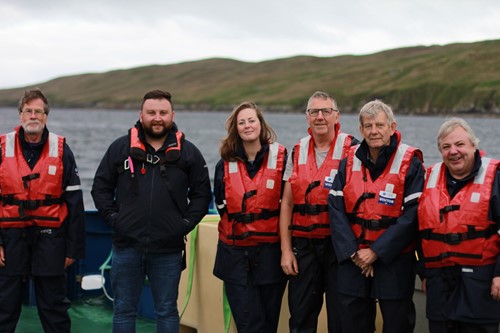Trials of pioneering new anti-sea lice treatment concept carried out in Shetland
A new anti-sea lice treatment concept under development to help make aquaculture more sustainable has successfully completed environmental safety trials of the state-of-the-art equipment in Scotland.
The multinational consortium behind the BREEZE initiative carried out the week-long trials at a salmon farm in Shetland, owned and operated by Scottish Sea Farms. The trials validated modelling already carried out and have shown that the sonic technology to treat fish against sea lice can operate safely in an open marine environment.
Rachel Brown, Global Innovation Manager of BREEZE consortium partner and project activity leader, Aqua Pharma Group, said: “These recent in-situ trials are a momentous milestone in this project. We know from our many years of treatment experience that the marine environment is challenging, and we know from our research so far that this system has the potential to be an effective treatment against sea lice. So it is great news that the equipment has performed well in these trials and we are a step closer to bringing a system to market that can really help make a difference to fish farmers.”
Ian Armstrong, Managing Director of BREEZE consortium partner, Pulcea, said: “Before the operational deployment of any physics-based technology, it is first necessary to understand the basic principles. Over the last four years, Pulcea has thoroughly researched how the technology enhances the efficacy of hydrogen peroxide against sea lice, allowing us to optimise the treatment in controlled tank experiments which safeguards fish welfare.
“The recent trials, undertaken without any fish present at the farm, have shown that this treatment can also be used under operational conditions without detriment to nearby marine mammal inhabitants or to human health.
“The BREEZE consortium is now ready to proceed to operational trials in Norway where the Commercial lead, Aqua Pharma Group, has the vessels and crew available for deployment of the Pulcea technology.”
Dr Ralph Bickerdike, Head of Fish Health at Scottish Sea Farms, said: “Contrary to what its name might suggest, hydrogen peroxide is extremely gentle both on fish and environment.
"Administered at a low concentration – typically, a tenth of the strength used in an everyday mouthwash – it's highly effective at dislodging sea lice before rapidly breaking down into just water and oxygen.
"To learn that its efficacy might be enhanced further by pairing it with sonic technology is of huge interest not just to Scottish Sea Farms but the wider sector."
Ashleigh Kitchiner, Senior Marine Mammal Consultant of APEM Ltd and Marine Mammal Observer for the trial, said, “It was a pleasure for APEM to work with the Aqua Pharma Group and Pulcea team on this research trial. It is clear they have placed a great deal of emphasis on protecting the marine environment whilst trying to ensure an efficacious treatment against sea lice. We are looking forward to working with them on future trials across Scotland.”
In 2021 the project consortium, made up of Aqua Pharma Group, Pulcea and the Norwegian University of Science & Technology, received funding from the European Union’s food innovation initiative EIT Food as part of its mission to make the aquaculture sector more sustainable and a vital part of a more healthy and trusted food system.

The team working on the trials, (l-r) Matt Geen, Matt Geen Consulting; Stuart Ferguson, Aqua Pharma; Ashleigh Kitchiner, APEM; Stephen Mark, S and A Techs; Steve Ellis, Industrial Noise & Vibration Centre; Ian Jamieson, Pulcea.
Read more articlesShare this